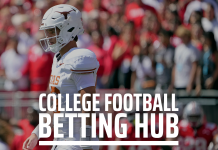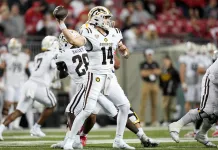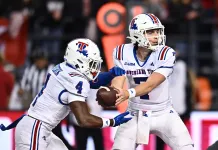College Football Home-Field Advantage:
How much does home-field advantage matter in college football? I don’t know. You don’t know either. Accounting for all of the variables and producing a statistically significant sample size in the current landscape of college football is impossible. But, that doesn’t mean that we want to simply guess what it means or what it’s worth.
My belief is that the value of home-field advantage is both quantitative and qualitative. With the help of VSiN’s Jason Latus and Steve Makinen, I’ve nailed down the quantitative part of the equation, at least as it pertains to my process.
I made a change to my process this season. The default home-field advantage remained two points, but I changed from a five-year sample size to a three-year sample size for determining a team’s HFA. I’m using Straight Up (SU) + Against The Spread (ATS) win percentage at home as my criteria.
Why the change? For starters, we’re further removed from COVID, so things have been more “normal.” Also, with the portal, coaching carousel, and all the other things that lead to personnel changes, five years simply felt too long.
In some ways, this does make my HFA numbers more “dynamic” in that they’re going to change more frequently year-over-year with teams dropping down or moving up based on their trendlines and I’m okay with that.
Teams are placed into “buckets” and ones that meet certain thresholds either go above or below the standard-issue two points. For this season, there are 20 teams with my max HFA of 3.5 points, nine teams with 3 points, 23 teams with 2.5 points, four teams with 1.5 points, and 11 teams with 1 point. That means exactly half (67) of the FBS teams (134) qualify one way or another. I did use two points for newcomer Kennesaw State without any data to rely on.
Here are those teams for the 2024 season:
3.5 Points (SU + ATS Home Win% of 70% or Higher)
- Alabama
- James Madison
- Kansas State
- Louisville
- LSU
- Michigan
- NC State
- Ohio State
- Oklahoma
- Oklahoma State
- Ole Miss
- Oregon
- Oregon State
- Penn State
- SMU
- Tennessee
- Texas
- Utah
- UTSA
3 Points (65-69.99%)
- Clemson
- Duke
- Georgia
- Liberty
- Louisiana
- Miami (OH)
- Texas A&M
- UCF
- West Virginia
2.5 Points (60-64.99%)
- Air Force
- Appalachian State
- Boise State
- Coastal Carolina
- Fresno State
- Iowa
- Jacksonville State
- Kentucky
- Michigan State
- New Mexico State
- North Carolina
- South Alabama
- South Carolina
- Syracuse
- TCU
- Texas Tech
- Toledo
- Troy
- UAB
- Wake Forest
- Washington State
- Western Kentucky
- Wyoming
*Note: Any team between 40-59.99% has a standard HFA of 2 points.*
1.5 Points (35.01-39.99%)
- Boston College
- Indiana
- Nevada
- Northern Illinois
1 Point (35% or Lower)
- Akron
- Buffalo
- Charlotte
- Colorado State
- FIU
- Georgia Tech
- New Mexico
- Stanford
- Tulsa
- UMass
- Vanderbilt
It is important with all elements of handicapping to think about potential pitfalls. For example, James Madison has 3.5 points of HFA for me, but the roster has changed and so has the head coach. Oregon State has also seen tremendous turnover and may not warrant 3.5 points without Jonathan Smith and with a depleted roster.
Those are part of the qualitative handicapping process. I use HFA in concert with my Power Ratings to put together game spreads in hopes of getting ahead of the market by betting lines early in the week. But, I still have to keep in the back of my mind that my line could be off because of how I’m valuing home-field for those teams. That being said, the decreases for those teams in my Power Ratings account for the coaching and roster turnover changes, and if those are efficient, it shouldn’t be that big of a deal.
What is impossible to nail down is how HFA differs between a nationally-televised ABC game under the lights with a liquored-up crowd and major stakes versus a Noon kickoff against a MAC team in Week 2. Dynamic home-field advantage values would be useful, but that is where sample size comes into play. We don’t have enough data points to make a definitive statement, especially in an era where players and coaches come and go depending on which way the wind is blowing.
So, what do we do? We do the best that we can. We come up with something. Some people use a blanket home-field advantage for every team, which I argue doesn’t take it far enough.
As a sabermetrician and a deep-diver when it comes to baseball stats, I’ll point to the difference between on-base percentage (OBP) and wOBA (weighted on-base average). OBP treats everything the same. A walk is just as valuable as a single and a double is just as valuable as a home run because the formula doesn’t differentiate between the ways of reaching base. wOBA, meanwhile, uses weighted run values to showcase that a home run is indeed more valuable than a double or a triple is weighted heavier than a walk. Predictably, I prefer wOBA over OBP.
In that same breath, playing in front of 1,000 people is not the same as playing in front of 10,000 people or 100,000 people. However, I could also argue that the teams playing road games in front of 100,000 people are way more accustomed to it than others, which, in theory, could cut down on the home-field advantage. They’re traveling in style, staying in nicer hotels, working with better dieticians, sleep therapists, and whoever else is on staff to accommodate the needs of the players.
Back in the VSiN 2022 College Football Betting Guide, I called home-field advantage an “inexact science”. I referred to that expression last season and refer to it again this season. But, like I said, I don’t want something random or completely arbitrary.
Therefore, while it is frustrating to not be able to truly pin down what HFA is worth, something is better than nothing., so we’ll see if that has an impact on both the offense and the defense.






